The 2K22 Tunguska is a Soviet tracked self-propelled anti-aircraft gun combined with a surface-to-air gun/missile system, day and night sights and capabilities, and offering full protection for infantry and tank regiments, notably against helicopters, even cruise missiles in the latter version. NATO reporting name for its short-range missiles is SA-19 "Grison". This replacement for the older ZSU-23-4 Shilka was fielded since 1982 in the Soviet Army and saw service however more recently with the Russian Army (c250 in service), in the Georgian war and current war in Ukraine.
It looks it shared a lot with the previous Shilka of the 1960s but the latter had only guns (SPAAG) whereas the new vehicle is a more complex SPAAGML, or "self propelled anti-aicraft gun/missile launcher". The road was long to get there, and so far the Russian Army still had no better vehicle in this role to field, despite a design going back to 1970...
Development of the Tunguska "complex" was entrusted to the Instrument Design Bureau (KBP) of the MOP (chief designer A.G. Shipunov) in cooperation with other organizations of USSR defense industries, by the Resolution of the CPSU Central Committee and the USSR Council of Ministers of June 8, 1970. Initially it was to provide a new anti-aircraft gun self-propelled unit (ZSU) to replace the famous "Shilka" (ZSU-23-4).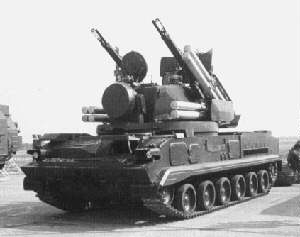 Despite the Shilka being already proven and well tested, notably in the Middle East, its shortcomings also were revealed, notably a short range, below 2 km, weak shells, and untimely detection, allowing the incoming enemy aircraft to strike first. The feasibility of increasing caliber for already large (23 mm) automatic anti-aircraft guns was explored. Experimental studies shown the transition from a 23 mm to a 30 mm with a 2-3x increase in warhead mass makes it possible to reduce the required number of hits to destroy an aircraft the same amount.
Despite the Shilka being already proven and well tested, notably in the Middle East, its shortcomings also were revealed, notably a short range, below 2 km, weak shells, and untimely detection, allowing the incoming enemy aircraft to strike first. The feasibility of increasing caliber for already large (23 mm) automatic anti-aircraft guns was explored. Experimental studies shown the transition from a 23 mm to a 30 mm with a 2-3x increase in warhead mass makes it possible to reduce the required number of hits to destroy an aircraft the same amount.
Comparative calculations of combat effectiveness for the ZSU-23-4 and hypothetical ZSU-30-4 when firing at a MiG-17 at 300 m/s showed that with the same ammunition mass consumed, the probability of destruction increased by approximately 1.5 times, the altitude being ported from 2,000 to 4,000 m. With an increase in caliber of guns, efficiency of firing at ground targets also increases and opened the use of cumulative-action projectiles to destroy lightly armored such as infantry fighting vehicles, so opening new ground support avenues. This transition however had virtually no effect on the rate of fire and makes it likely to prevent a higher rate of fire.
The Shilka ZSU had limited detection capabilities due to the state of Soviet electronics at the time, so the emergency was to provide the hypothetical new ZSU-30-4 with a much better target tracking radar to cover 40° in azimuth and perform a change in elevation within 7° compared to antenna axis. The efficiency of the ZSU-23-4 was only right when preliminary target designation was received from the battery command post PU-12, with data received from the divisional air defense chief using a P-type all-round radar -15 (P-19). As in many aspects, a very hierarchical command structure in contrast with NATO practice. If there was breakage of communication at any of these levels, the ZSU was blind, or could detect a target already closing in by pure luck.
In the absence of target designations, the ZSU radar was only able to make an autonomous circular search, but its efficiency of detection was less than 20%. To ensure combat autonomous operation and high firing efficiency, the new vehicle was to have an all-round radar with 16-18 km in range on a 30 m accuracy base, to ensure time to answer, as well as a visibility in elevation of at least 20°. However, the feasibility of this system raised great doubts in the Minister of Defense A.A. Grechko office. Not only that, but funding for further development of the new self-propelled gun in 1975-1977 delayed the project, and prevented an entry into service by 1975.
ZSU artist impression, initial version, pbased on a T-72 chassis
Meanwhile, development around the "universal" Osa-AK air defense system for similar-sized aircraft in an engagement zone up to 10 km at 0.025-5 km altitude and roughly same characteristics for effectiveness of destruction had its supporters, which wanted to scrap the project entirely and create a SPAAML instead.
But this did not take into account the specifics of the regimental air defense division for which the ZSU was intended and the shortcomings when fighting helicopters of the Osa-AK, quite inferior to the ZSU-30-4, with longer operating time, 30 seconds between launches, whereas the SPAAG could provide almost continuous fire and had a shorter reaction time. Thus the debate between the proèSPAAG and pro-SPAAML raged on in Soviet military circles, with the MoD as arbiter leaning towards the second.
Soviet intel however could provided already masses of data from the Vietnam War, where helicopters armed with anti-tank guided missiles (ATGM) such as the Huey Cobra were used against NVA tanks showing 89 out of 91 helicopters had a kill on first launch, also on artillery firing positions or fixed targets. The US Army soon had helicopter units organic to each US division of combat armored vehicles, their guardian angels.
This was of course likely to be ported in NATO doctrines and met on a potential Eastern Europe battlefield. A group of fire support helicopters, together with a reconnaissance helicopter, could use the terrain at their advantage, staying hidden at 3-5 km from the line of contact before “jumping” up 15-25 m and immediately hit tanks with their ATGMs, then quickly disappeared.
As a result of the research, it was determined that Soviet modern tanks, and th weapons used to destroy ground targets in motorized rifle, tank and artillery formations, were not adequate. The Osa air defense systems only worked for advancing tank units advancing in plain fields, flat terrain from aircraft attacks, but completely unable to prevent attacks by helicopters in this new style. It was determine that the positions for these mobile air defense assets were to up to 5-7 km from the positions of attacking helicopters, which was mostly not the case, the latter surging from behind any obstacle and stay 20-30 seconds to fire before disappearing. Based on their reaction time, both Osa and Osa-AK were not able to answer.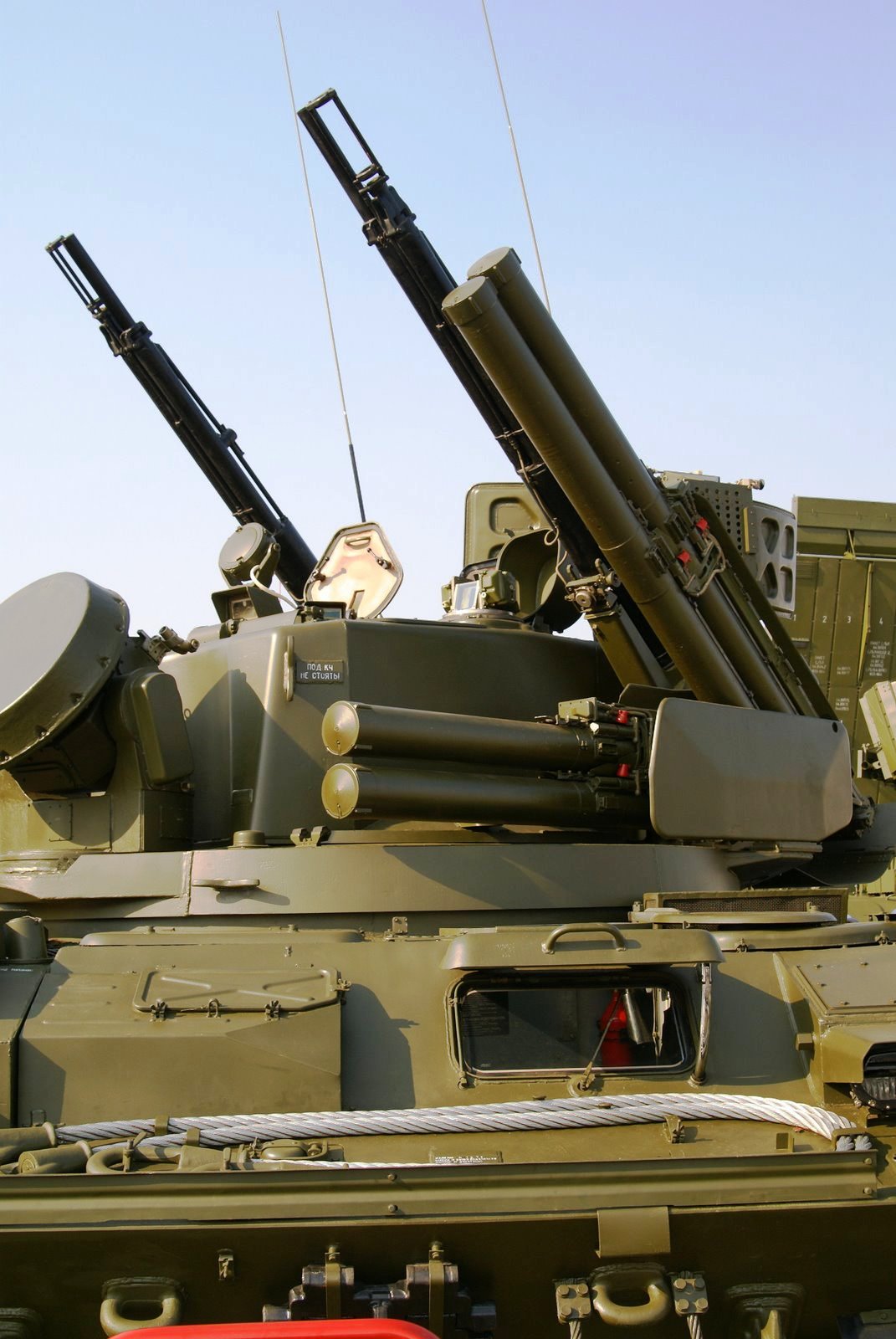
The complementary Strela-2, Strela-1 and Shilka air defense systems were also unable to deal with these tactics, leaving the only anti-aircraft asset pertinent in this configuration, the traditional ZSU, between its short reaction time pof a mere seconds and short 4-8 km engagement sphere. The ball in 1973 seemed back in the hands of the SPAAG advocates, and development resumed, by KBP MOP (chief designer A.G. Shipunov) for the main carrier vehicle, hull and turret. Guns and rockets, were under the respective care of V.P. Gryazev and V.M. Kuznetsov.
The Ulyanovsk Mechanical Plant was also contacted for the communication set under chief designer Yu.E. Ivanov, the the Minsk Tractor Plant wa contacted for the GM-352 tracked chassis and extra power supply system (to activate radar and weapons when the engine was cold), and All-Russian Scientific Research Institute "Signal" for the guidance systems, gun stabilization, optical sight, and navigation equipment, as well as LOMO for the sightis and optical equipments among others. Joint, state tests of the finished prototype, by then called the "Tunguska complex" were carried out from September 1980 to December 1981 at the Donguz test site.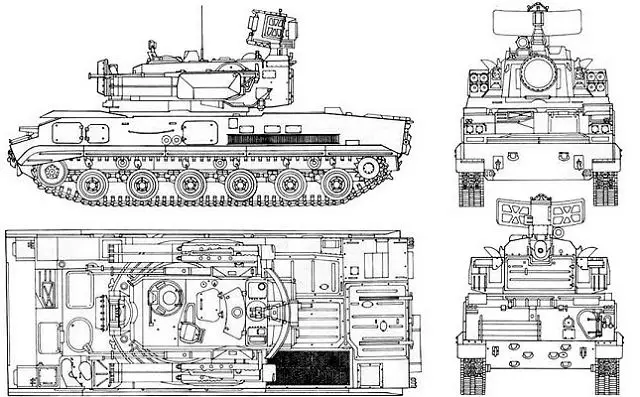
The ZSU 2S6 or 2K22 in GRAU designation consists of the GM 352 tracked chassis, combined with a 2A40 turret, containing the RCK 1A27 radio set, 1RL144 radar, 1A26 digital computer and 1G30 roll angle measurement system with sensors on the central island and two articulated arms for the two twin autocannons, and independently elevated four missile tubes or either side.
The driver is located on the left, with access through a top sliding hatch, and single vision block with IR option for night driving. When not button up in combat, he can see the road behind a window under a lifting panel.
For semi-active protection there is a automatic fire-fighting system, a collevtive BNC equipment with chemical and radiadiological detection and sealing, overpressure, ventilation and air conditioning, aboard plus external surveillance equipment and laser warning. The vehicles are equipped in addition with four smoke dischargers located in two banks, either side of the forward slopes of the hull nose.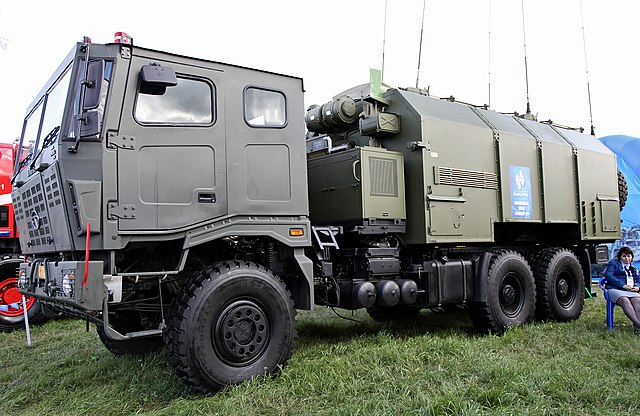
The new Ranzhir Command Post Vehicle
The ZSU 2S6 is mounted on the chassis of the MT-T multi-purpose tracked heavy transporter with an hydromechanical transmission and hydropneumatic suspension, with variable ground clearance providing high cross-country ability and smooth ride over rough terrain. The main Engine at the rear of the chassis is the V-46-6-MS centrifugal turbocharged V-12 diesel, with direct fuel injection; working at max 2,000 rpm. It is water cooled, 4-stroke and multi-fuel. It has a starter working under −40 to +50°C temperatures, with a relative humidity of 98% at 20°C and up to 3,000 m altitude, so with compressed air injection.
This engine is rated for 580 kW (780 hp) on flat, in unladen conditions, and up to 630 kW (840 hp) maximum, ungoverned. The Transmission is Hydromechanical and Suspension Hydropneumatic, authorizing a Ground clearance ranging from 17 to 57 cm (7-18 inches). Operational range in normal road conditions is around 500 km (310 mi) with a top speed of 65 km/h (40 mph) max on road.
The power supply could come from the electric system which source is a direct current generator, which rotor is driven by a gas turbine engine or regular engine as APU. The converter unit allowed to have electricity into three-phase alternating with a frequency of 400 Hz, voltage of 220 V, enough for the entire turret systems and equipment when the vehicle's engine is shut down. The power tracking drive is designed for automated guidance and stabilization of the turret according to signals from the gyroscopic unit, commander's input as well or semi-automatic guidance when in combat with a target tracking.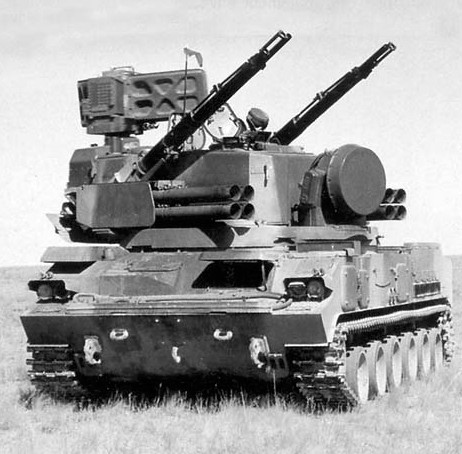 The turret is equipped with an optical sight, 1A29 guidance and stabilization system, a navigation equipment, external R-173 radio station and 1B116 intercom. Outside of the turret forward is lotaed the antenna column for the tracking station and opposite, guides for the 9M311 missiles and 2A38 anti-aircraft guns. On the roof, rear is the antenna column for the detection and target designation station.
The turret is equipped with an optical sight, 1A29 guidance and stabilization system, a navigation equipment, external R-173 radio station and 1B116 intercom. Outside of the turret forward is lotaed the antenna column for the tracking station and opposite, guides for the 9M311 missiles and 2A38 anti-aircraft guns. On the roof, rear is the antenna column for the detection and target designation station.
The interior is divided into a control compartment, artillery and aft compartments. The former in the front part of the turret houses the main artillery compartment, up to the middle section cap. The weapons station is called the 1A27 complex, performing search, detection and tracking of air targets, issuing guidance data for the autocannons, missile control data, generation of current values relative to the reference point through the ballistic computer, and provides indication on the commander's console in the operating modes of the radar system.
An optical sight with guidance and stabilization system is providing search, detection, tracking of air and ground targets, determination of differences between the position of the missile and optical line of sight (SACLOS) of the sighting equipment. The turret body is a roughly parallelipedic volume with slightly slanted front, a large blocky structure behind, supporting the two heavy arms for the main weapons system. It is placed on a wide circular base built above the main ring (and superior in diameter). In front of the turret lays the primary dish-like guidance radar, which had both limited traverse and elevation. The turret roof is occupied by the commander and gunner's posts and hatches, an, IR projector, and massive 360° gunner's sight. At the rear of the structure is located the base for the main surveillance, acquisition radar.
The 2A38 operates at elevation angles from −9° to +85°. The cartridge belt consists of links with cartridges. The basic rounds are high-explosive, fragmentation, incendiary and armor-piercing, plus tracer shells in a ratio of 4:1 in the belt to keep track visually of the target. Rate of fire is 4060-4810 rounds/min. The barrel life os around 8,000 rounds in firing mode of 100 shots bursts, with subsequent cooling. Mzzule velocity is 960-980 m/s. These guns are also common to the 96K6 "Pantsir-S1".
When firing the Anti-aircraft guns, the digital computer system solves targeting coordinates and determine the affected area based on data from the tracking station antenna, through the computer unit isolating error signals by angular coordinates, and data from the range finder, as well as from the angle measure system to fire on the move. In the event of electronic interference to the tracking station, a a manual tracking backup is possible, backed by an inertial tracking. There is also an optical sight and inertial data provided by the digital computer system. Four groups of four tubes with independent elevation are fixed on the two external arms on the turret's sides. They could fire eight 9M311, 9M311K, 9M311-1, 9M311M, 9M311-M1 or 57E6 missiles, without reload. The 9M311 ATM is a 76 mm (3-inches) 41.6 kg missile under Semi-Automatic guidance. Its maximum speed is 910 m/s, 32 G tolerance, 8 km range, issile 13.5 secs guidance tim, max, and carried a 4.62 kg TNT eq. warhead with a fuze sensitivity of 0.1 mm, arming distance of 300 m, trigger radius of 5 m and armour penetration of 39 mm which is quite enough to deal with all sorts of helicopters and aircraft.
Four groups of four tubes with independent elevation are fixed on the two external arms on the turret's sides. They could fire eight 9M311, 9M311K, 9M311-1, 9M311M, 9M311-M1 or 57E6 missiles, without reload. The 9M311 ATM is a 76 mm (3-inches) 41.6 kg missile under Semi-Automatic guidance. Its maximum speed is 910 m/s, 32 G tolerance, 8 km range, issile 13.5 secs guidance tim, max, and carried a 4.62 kg TNT eq. warhead with a fuze sensitivity of 0.1 mm, arming distance of 300 m, trigger radius of 5 m and armour penetration of 39 mm which is quite enough to deal with all sorts of helicopters and aircraft.
Fire from 30-mm 2A38 cannons can be made on the move or static, while the missiles can only be launched static. The fire control system is radar-optical. A surveillance radar with a target detection range of 18 km is located at the rear of the turret and in front the target tracking radar provides guidance data with a range of 13 km. In addition to the radar, the fire control system includes a digital computer, stabilized optical sight and angle measuring instruments. Reaction time is 6-8 s.
When firing missiles, target tracking with angular coordinates using the optical sight are provided. After launch, the missile is guided by field of view in optical direction finder plus coordinates selection equipment. Based on the light signal from the missile tracer, angular coordinates are determined automatically relative to the target’s line of sight via the computer, generating instant missile control corrections via an encoder, converted into pulses before transmission.
The missile is guided for its entire trajectory and deviation from the target line of sight by 1.5 d.u. reducing the likelihood of thermal interference. When the missile approaches the target from 1000 m, a radio command is transmitted to the missile, to arm the close contact sensor. After a time corresponding to the target meeting point, the fuse is detonated, whereas data is automatically transferred to the next missile to launch. If there was no information in the computer about range of from tracking or detection stations, an additional missile guidance mode could be use to bring the missile into direct target line of sight and the fuse cocked 3.2 s after the missile launch.
Guidance to the target relies in the gunner using control signals from his console or from the central station. The combat vehicle has a navigation, topographical reference and orientation system for determining coordinates.
-carrying out technical maintenance of products 1RL144, 1A26, 1A29, 2E29VM, 1G30, block Sh1;
-restoring the functionality of products 1RL144, 1A26, 1A29, 2E29VN, 2E29GN, 1G30, electrical equipment of products 2A40 and the Sh1 unit by replacing faulty blocks, sub-blocks and wall-mounted elements with serviceable ones from the group kit of spare parts for the ZSU;
-performance monitoring, testing and configuration of individual units and systems included in the ZSU 2S6.
-transportation of the training device 1RL912.
Main improvements were the following:
-Introduction of new radio sets
-Better data receiver and data link with the Ranzhir battery command post (PU-12M) and PPRU-1M (PPRU-1) command post.
-For mobility, the APU gas turbine engine was replaced by a better one with increased life span of 600 instead of 300 hours.
-Processes for missile guidance and datalink with the battery command post made automatic.
-9M311M missile couplmed with a radar target sensor increasing capabilities against incoming
-Pulse lamp installed for an efficiency increased by 1.3-1.5 times -Missile range 10 km. -GM-352 chassis produced in Belarus replaced by the GM-5975 from Mytishchi Metrovagonmash in Russia.
-Better receiver/transmitter for automated external target designation
-Interfacing via radio channel with the battery command post (possible to automatically distribute targets from the Ranzhir battery)
-Unloading schemes to facilitate the gunner’s work when tracking a moving air target with optical sight, simplified for stationary target, reducing errors.
-Better system to isolate coordinates in connection with a new missile
-Continuous light source plus pulsed one to increase noise immunity and combat optical interference.
-New missile with 10 km range
-Upgraded Sensors for pitching and heading angles to reduce disturbing influences on the gyroscopes,
-Better corrections of measures for tilt angles and heading
-Increased stability for the control loop of the anti-aircraft guns for better accuracy.
-Shorter operating time before missile launches
-NDTS type detection sensors with circular pattern and 5 m+ radius for small targets such as cruise missile.
-Modernization of the control system for the optical sight
-Central heating system
-New radar display to simplify target tracking by the gunner
-Adaptation of the system to the optical channel on the level of training of the gunner.
In short, the 2K22M1 or 2S6M1 as also called, brought to the table a new digital interface Ranzhir automated command-and-control system, new fire control system, and new missile 9M311M with 10 km range. As of today, production is still ongoing on this standard, already 20 years old, and work is underway towards an improved 2S6M1 with a new thermal imaging channel with automatic tracking for a true 24-hour missile guard on the move. The M1 was estimated 1.3-1.5 times better compared to the Tunguska-M already. Replacement would likely be, if any planned for the later 2020s either an upgrade or a brand new SPAAGML, still combining two weapons systems for the reasons seen above.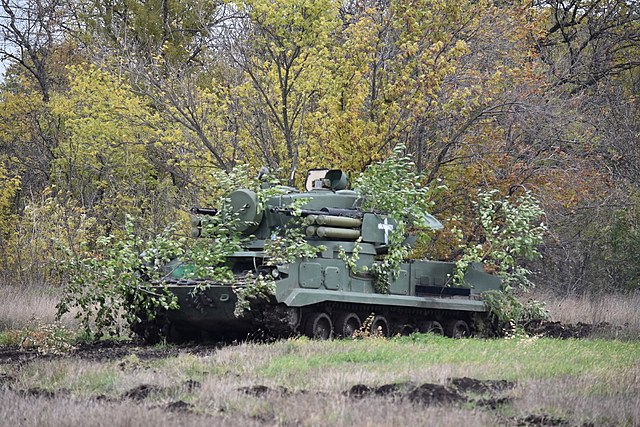
Ukrainian vehicle part of the 30th Brigade, Camouflaged in 2022
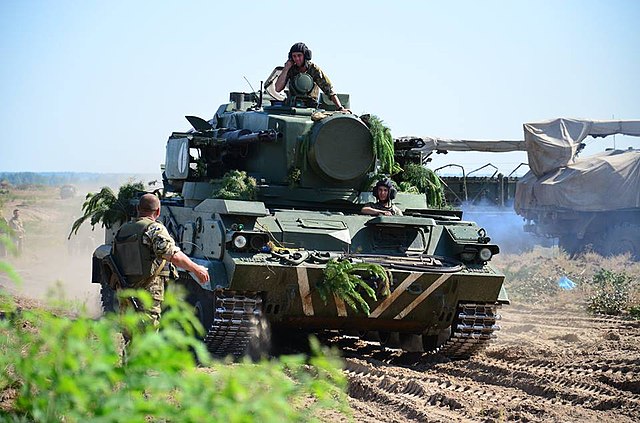
2S6 Ukrainian Army
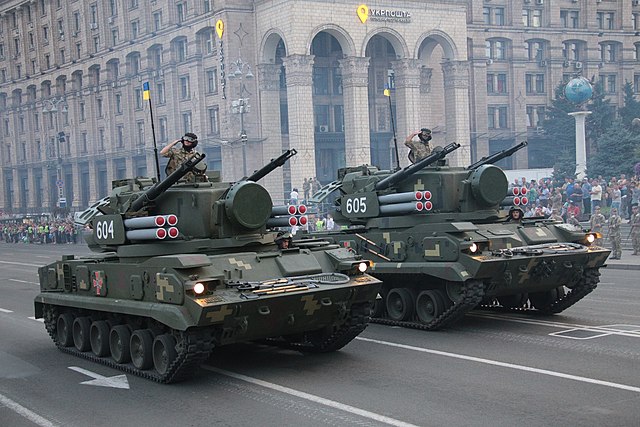
Ukrainian 9K22M1
NATO named the new vehicle under the designation SA-19 "Grison". Organizationally, 4 vehicles are combined into an anti-aircraft/artillery platoon from AA missile and artillery battery, consisting of a platoon of Strela-10SV and platoon of Tunguskas. The battery is part of the anti-aircraft division of a motorized rifle (tank) regiment.
The 2K22 system consists of combat equipment, maintenance equipment and training equipment provided by the 1P10-1 and 2V110-1 vehicles. A battery of 2K22s could also consist for support of six combat vehicles, repair and maintenance machine 1Р10-1 and 2V110-1, 2F55-1, transport-loading truck 2F77M, mobile diesel power plant ESD2-12, MTO-AG-1M workshop for the chassis maintenance alone, and AKIPS 9V921 automated control and testing mobile station for the 9M311 missiles. There could be also a training unit 1RL912, designed for training the commander and operator, and the 9F810 simulator, for the gunner.
The PU-12M control post is connected to the AA division commander and the regiment air defense chief, in a battery command post. This is the control point for air defense units of the regiment. This unit is called the "Ovod-M-SV" (mobile reconnaissance and control point) and its modernized version the "Assembly-M" (PPRU-1M) with modrnization including interfacing with the unified battery command post 9S737 Ranzhir.
When paired with the Tunguska complex with the PU-12M, control commands and control commands from the latter to the combat vehicles were to be transmitted by voice using standard radio stations, and when paired with the 9S737 command post - using codegrams generated by data transmission equipment, which should have been these facilities are equipped. In the case of control of the Tunguska complexes from a battery command post, the analysis of the air situation and the selection of targets for firing by each complex should have been carried out at this point.
In this case, orders and target designations were to be transmitted to combat vehicles, and data on the condition and results of the complex’s combat operation were to be transmitted from the complexes to the battery station. It was intended in the future to provide direct interface between the anti-aircraft gun and missile system and the command post of the air defense chief of the regiment using a telecode data line.
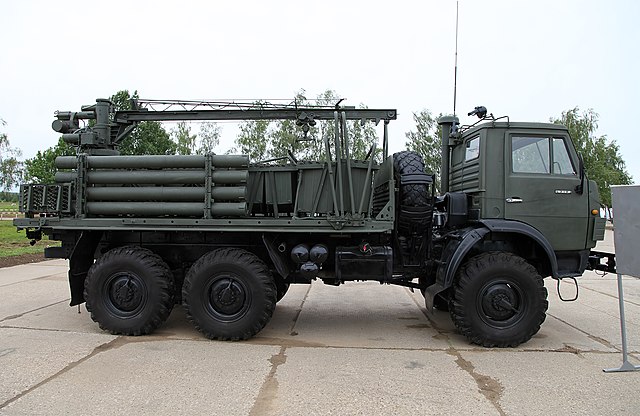
2F77M transloading vehicle
The Tunguska air defense missile system and its modifications are in service with the armed forces of Russia and Belarus. In 1999, Russia began supplying the Tunguska-M1 air defense missile system to India in a total quantity of 60 units. Previously, India acquired 20 Tunguska complexes. According to some reports, the complex was delivered to the UK in single quantities through the Voentekh Group of Companies in the mid-90s. Belarus: 176 2S6
Belarus: 176 2S6
 India: Up to 80 2S6 s of 2023
India: Up to 80 2S6 s of 2023
 Morocco: 12 2К22М1s as of 2012
Morocco: 12 2К22М1s as of 2012
 Myanmar: 38 from Russia (2004-2007=, 3 from Ukraine 2019
Myanmar: 38 from Russia (2004-2007=, 3 from Ukraine 2019
 Russia: 250+ 2К22s in 2012 (Military Balance 2012), 21 more delivered 2012–2017.
Russia: 250+ 2К22s in 2012 (Military Balance 2012), 21 more delivered 2012–2017.
 Syria: 6 2S6М1s in 2008
Syria: 6 2S6М1s in 2008
 Ukraine: 70 2S6s in 2012 (Military Balance 2012), 75 by 2021.
Ukraine: 70 2S6s in 2012 (Military Balance 2012), 75 by 2021.
Development
The 2K22 Tunguska anti-aircraft missile/gun system was designed for air defense of motorized rifle and tank units on the march for all types of terrain and combat situations, setup to destroy low-flying air targets, including hovering helicopters. It was adopted into service in the mid-eighties. Its standard "universal" chassis was mated with a turret with two double-barreled 30-mm automatic cannons and eight missile launchers for short range anti-aircraft guided missiles.It looks it shared a lot with the previous Shilka of the 1960s but the latter had only guns (SPAAG) whereas the new vehicle is a more complex SPAAGML, or "self propelled anti-aicraft gun/missile launcher". The road was long to get there, and so far the Russian Army still had no better vehicle in this role to field, despite a design going back to 1970...
Development of the Tunguska "complex" was entrusted to the Instrument Design Bureau (KBP) of the MOP (chief designer A.G. Shipunov) in cooperation with other organizations of USSR defense industries, by the Resolution of the CPSU Central Committee and the USSR Council of Ministers of June 8, 1970. Initially it was to provide a new anti-aircraft gun self-propelled unit (ZSU) to replace the famous "Shilka" (ZSU-23-4).
Towards the ZSU-30-4 SPAAG
 Despite the Shilka being already proven and well tested, notably in the Middle East, its shortcomings also were revealed, notably a short range, below 2 km, weak shells, and untimely detection, allowing the incoming enemy aircraft to strike first. The feasibility of increasing caliber for already large (23 mm) automatic anti-aircraft guns was explored. Experimental studies shown the transition from a 23 mm to a 30 mm with a 2-3x increase in warhead mass makes it possible to reduce the required number of hits to destroy an aircraft the same amount.
Despite the Shilka being already proven and well tested, notably in the Middle East, its shortcomings also were revealed, notably a short range, below 2 km, weak shells, and untimely detection, allowing the incoming enemy aircraft to strike first. The feasibility of increasing caliber for already large (23 mm) automatic anti-aircraft guns was explored. Experimental studies shown the transition from a 23 mm to a 30 mm with a 2-3x increase in warhead mass makes it possible to reduce the required number of hits to destroy an aircraft the same amount.
Comparative calculations of combat effectiveness for the ZSU-23-4 and hypothetical ZSU-30-4 when firing at a MiG-17 at 300 m/s showed that with the same ammunition mass consumed, the probability of destruction increased by approximately 1.5 times, the altitude being ported from 2,000 to 4,000 m. With an increase in caliber of guns, efficiency of firing at ground targets also increases and opened the use of cumulative-action projectiles to destroy lightly armored such as infantry fighting vehicles, so opening new ground support avenues. This transition however had virtually no effect on the rate of fire and makes it likely to prevent a higher rate of fire.
The Shilka ZSU had limited detection capabilities due to the state of Soviet electronics at the time, so the emergency was to provide the hypothetical new ZSU-30-4 with a much better target tracking radar to cover 40° in azimuth and perform a change in elevation within 7° compared to antenna axis. The efficiency of the ZSU-23-4 was only right when preliminary target designation was received from the battery command post PU-12, with data received from the divisional air defense chief using a P-type all-round radar -15 (P-19). As in many aspects, a very hierarchical command structure in contrast with NATO practice. If there was breakage of communication at any of these levels, the ZSU was blind, or could detect a target already closing in by pure luck.
In the absence of target designations, the ZSU radar was only able to make an autonomous circular search, but its efficiency of detection was less than 20%. To ensure combat autonomous operation and high firing efficiency, the new vehicle was to have an all-round radar with 16-18 km in range on a 30 m accuracy base, to ensure time to answer, as well as a visibility in elevation of at least 20°. However, the feasibility of this system raised great doubts in the Minister of Defense A.A. Grechko office. Not only that, but funding for further development of the new self-propelled gun in 1975-1977 delayed the project, and prevented an entry into service by 1975.
The advantages of SAM

ZSU artist impression, initial version, pbased on a T-72 chassis
Meanwhile, development around the "universal" Osa-AK air defense system for similar-sized aircraft in an engagement zone up to 10 km at 0.025-5 km altitude and roughly same characteristics for effectiveness of destruction had its supporters, which wanted to scrap the project entirely and create a SPAAML instead.
But this did not take into account the specifics of the regimental air defense division for which the ZSU was intended and the shortcomings when fighting helicopters of the Osa-AK, quite inferior to the ZSU-30-4, with longer operating time, 30 seconds between launches, whereas the SPAAG could provide almost continuous fire and had a shorter reaction time. Thus the debate between the proèSPAAG and pro-SPAAML raged on in Soviet military circles, with the MoD as arbiter leaning towards the second.
Soviet intel however could provided already masses of data from the Vietnam War, where helicopters armed with anti-tank guided missiles (ATGM) such as the Huey Cobra were used against NVA tanks showing 89 out of 91 helicopters had a kill on first launch, also on artillery firing positions or fixed targets. The US Army soon had helicopter units organic to each US division of combat armored vehicles, their guardian angels.
This was of course likely to be ported in NATO doctrines and met on a potential Eastern Europe battlefield. A group of fire support helicopters, together with a reconnaissance helicopter, could use the terrain at their advantage, staying hidden at 3-5 km from the line of contact before “jumping” up 15-25 m and immediately hit tanks with their ATGMs, then quickly disappeared.
As a result of the research, it was determined that Soviet modern tanks, and th weapons used to destroy ground targets in motorized rifle, tank and artillery formations, were not adequate. The Osa air defense systems only worked for advancing tank units advancing in plain fields, flat terrain from aircraft attacks, but completely unable to prevent attacks by helicopters in this new style. It was determine that the positions for these mobile air defense assets were to up to 5-7 km from the positions of attacking helicopters, which was mostly not the case, the latter surging from behind any obstacle and stay 20-30 seconds to fire before disappearing. Based on their reaction time, both Osa and Osa-AK were not able to answer.
Towards a SPAAGML
The complementary Strela-2, Strela-1 and Shilka air defense systems were also unable to deal with these tactics, leaving the only anti-aircraft asset pertinent in this configuration, the traditional ZSU, between its short reaction time pof a mere seconds and short 4-8 km engagement sphere. The ball in 1973 seemed back in the hands of the SPAAG advocates, and development resumed, by KBP MOP (chief designer A.G. Shipunov) for the main carrier vehicle, hull and turret. Guns and rockets, were under the respective care of V.P. Gryazev and V.M. Kuznetsov.
The Ulyanovsk Mechanical Plant was also contacted for the communication set under chief designer Yu.E. Ivanov, the the Minsk Tractor Plant wa contacted for the GM-352 tracked chassis and extra power supply system (to activate radar and weapons when the engine was cold), and All-Russian Scientific Research Institute "Signal" for the guidance systems, gun stabilization, optical sight, and navigation equipment, as well as LOMO for the sightis and optical equipments among others. Joint, state tests of the finished prototype, by then called the "Tunguska complex" were carried out from September 1980 to December 1981 at the Donguz test site.
Detailed Design

The ZSU 2S6 or 2K22 in GRAU designation consists of the GM 352 tracked chassis, combined with a 2A40 turret, containing the RCK 1A27 radio set, 1RL144 radar, 1A26 digital computer and 1G30 roll angle measurement system with sensors on the central island and two articulated arms for the two twin autocannons, and independently elevated four missile tubes or either side.
Hull and layout
The 2K22 uses the same "universal chassis" GM 352 (the GM stands for Gusenichnaya Mashina, lit. tracked machine) manufactured in Bielorussia (later GM-5975), and already used for a variety of vehicles: The GM-575 was used for ZSU-23-4 Shilka, the GM-5965 is used for Ranzhir-M command vehicle (directing the Tor, Tunguska, Strela-10, Igla and Osa) for example. Ths chassis family allowed to share a great variety of components, and all had a tailored centra usable compartment, and a separated engine compartment at the rea, driver and transmission in the formward compartment. The upper and sides are modular and designed to add a large variety of access hatches. The Exhaust grille was at the right.The driver is located on the left, with access through a top sliding hatch, and single vision block with IR option for night driving. When not button up in combat, he can see the road behind a window under a lifting panel.
Protection
For passive protection, the armored body of the GM-352 tracked chassis and the turret atop protects the crew from 7.62 mm bullets and shrapnel, so understand 7-12 mm (0.5 in) of RHA at best, the thickest on the glacis nose, well sloped. Despite its main armament usable for gtound support potentially capable of defeatiung an IFV, the 2K22 will not withstand a single autocannon round anywhere. There are also musguards with short rubber skirts above and along the drive train.For semi-active protection there is a automatic fire-fighting system, a collevtive BNC equipment with chemical and radiadiological detection and sealing, overpressure, ventilation and air conditioning, aboard plus external surveillance equipment and laser warning. The vehicles are equipped in addition with four smoke dischargers located in two banks, either side of the forward slopes of the hull nose.
Powerplant and mobility

The new Ranzhir Command Post Vehicle
The ZSU 2S6 is mounted on the chassis of the MT-T multi-purpose tracked heavy transporter with an hydromechanical transmission and hydropneumatic suspension, with variable ground clearance providing high cross-country ability and smooth ride over rough terrain. The main Engine at the rear of the chassis is the V-46-6-MS centrifugal turbocharged V-12 diesel, with direct fuel injection; working at max 2,000 rpm. It is water cooled, 4-stroke and multi-fuel. It has a starter working under −40 to +50°C temperatures, with a relative humidity of 98% at 20°C and up to 3,000 m altitude, so with compressed air injection.
This engine is rated for 580 kW (780 hp) on flat, in unladen conditions, and up to 630 kW (840 hp) maximum, ungoverned. The Transmission is Hydromechanical and Suspension Hydropneumatic, authorizing a Ground clearance ranging from 17 to 57 cm (7-18 inches). Operational range in normal road conditions is around 500 km (310 mi) with a top speed of 65 km/h (40 mph) max on road.
The power supply could come from the electric system which source is a direct current generator, which rotor is driven by a gas turbine engine or regular engine as APU. The converter unit allowed to have electricity into three-phase alternating with a frequency of 400 Hz, voltage of 220 V, enough for the entire turret systems and equipment when the vehicle's engine is shut down. The power tracking drive is designed for automated guidance and stabilization of the turret according to signals from the gyroscopic unit, commander's input as well or semi-automatic guidance when in combat with a target tracking.
Turret
 The turret is equipped with an optical sight, 1A29 guidance and stabilization system, a navigation equipment, external R-173 radio station and 1B116 intercom. Outside of the turret forward is lotaed the antenna column for the tracking station and opposite, guides for the 9M311 missiles and 2A38 anti-aircraft guns. On the roof, rear is the antenna column for the detection and target designation station.
The turret is equipped with an optical sight, 1A29 guidance and stabilization system, a navigation equipment, external R-173 radio station and 1B116 intercom. Outside of the turret forward is lotaed the antenna column for the tracking station and opposite, guides for the 9M311 missiles and 2A38 anti-aircraft guns. On the roof, rear is the antenna column for the detection and target designation station.
The interior is divided into a control compartment, artillery and aft compartments. The former in the front part of the turret houses the main artillery compartment, up to the middle section cap. The weapons station is called the 1A27 complex, performing search, detection and tracking of air targets, issuing guidance data for the autocannons, missile control data, generation of current values relative to the reference point through the ballistic computer, and provides indication on the commander's console in the operating modes of the radar system.
An optical sight with guidance and stabilization system is providing search, detection, tracking of air and ground targets, determination of differences between the position of the missile and optical line of sight (SACLOS) of the sighting equipment. The turret body is a roughly parallelipedic volume with slightly slanted front, a large blocky structure behind, supporting the two heavy arms for the main weapons system. It is placed on a wide circular base built above the main ring (and superior in diameter). In front of the turret lays the primary dish-like guidance radar, which had both limited traverse and elevation. The turret roof is occupied by the commander and gunner's posts and hatches, an, IR projector, and massive 360° gunner's sight. At the rear of the structure is located the base for the main surveillance, acquisition radar.
Armament
30mm 2A38 cannons
The twin-barrel 2A38 30 mm autocannons are located on the inner part of the articulated arms, close to the inner quad tube SAM launchers. The guns has a cooling sleeve and liquid-cooling system with antifreeze at negative air temperatures. 1,904 rounds carried, HE by preselection, but alternated of needed with AP rounds depending on the mission. It is fed by a common cartridge belt for the two barrels, using a single feed mechanism. There is a firing mechanism on the left and right barrels alternately to avoid interference. Firing control is remote, using an electric trigger.The 2A38 operates at elevation angles from −9° to +85°. The cartridge belt consists of links with cartridges. The basic rounds are high-explosive, fragmentation, incendiary and armor-piercing, plus tracer shells in a ratio of 4:1 in the belt to keep track visually of the target. Rate of fire is 4060-4810 rounds/min. The barrel life os around 8,000 rounds in firing mode of 100 shots bursts, with subsequent cooling. Mzzule velocity is 960-980 m/s. These guns are also common to the 96K6 "Pantsir-S1".
When firing the Anti-aircraft guns, the digital computer system solves targeting coordinates and determine the affected area based on data from the tracking station antenna, through the computer unit isolating error signals by angular coordinates, and data from the range finder, as well as from the angle measure system to fire on the move. In the event of electronic interference to the tracking station, a a manual tracking backup is possible, backed by an inertial tracking. There is also an optical sight and inertial data provided by the digital computer system.
Missiles
 Four groups of four tubes with independent elevation are fixed on the two external arms on the turret's sides. They could fire eight 9M311, 9M311K, 9M311-1, 9M311M, 9M311-M1 or 57E6 missiles, without reload. The 9M311 ATM is a 76 mm (3-inches) 41.6 kg missile under Semi-Automatic guidance. Its maximum speed is 910 m/s, 32 G tolerance, 8 km range, issile 13.5 secs guidance tim, max, and carried a 4.62 kg TNT eq. warhead with a fuze sensitivity of 0.1 mm, arming distance of 300 m, trigger radius of 5 m and armour penetration of 39 mm which is quite enough to deal with all sorts of helicopters and aircraft.
Four groups of four tubes with independent elevation are fixed on the two external arms on the turret's sides. They could fire eight 9M311, 9M311K, 9M311-1, 9M311M, 9M311-M1 or 57E6 missiles, without reload. The 9M311 ATM is a 76 mm (3-inches) 41.6 kg missile under Semi-Automatic guidance. Its maximum speed is 910 m/s, 32 G tolerance, 8 km range, issile 13.5 secs guidance tim, max, and carried a 4.62 kg TNT eq. warhead with a fuze sensitivity of 0.1 mm, arming distance of 300 m, trigger radius of 5 m and armour penetration of 39 mm which is quite enough to deal with all sorts of helicopters and aircraft.
Fire from 30-mm 2A38 cannons can be made on the move or static, while the missiles can only be launched static. The fire control system is radar-optical. A surveillance radar with a target detection range of 18 km is located at the rear of the turret and in front the target tracking radar provides guidance data with a range of 13 km. In addition to the radar, the fire control system includes a digital computer, stabilized optical sight and angle measuring instruments. Reaction time is 6-8 s.
When firing missiles, target tracking with angular coordinates using the optical sight are provided. After launch, the missile is guided by field of view in optical direction finder plus coordinates selection equipment. Based on the light signal from the missile tracer, angular coordinates are determined automatically relative to the target’s line of sight via the computer, generating instant missile control corrections via an encoder, converted into pulses before transmission.
The missile is guided for its entire trajectory and deviation from the target line of sight by 1.5 d.u. reducing the likelihood of thermal interference. When the missile approaches the target from 1000 m, a radio command is transmitted to the missile, to arm the close contact sensor. After a time corresponding to the target meeting point, the fuse is detonated, whereas data is automatically transferred to the next missile to launch. If there was no information in the computer about range of from tracking or detection stations, an additional missile guidance mode could be use to bring the missile into direct target line of sight and the fuse cocked 3.2 s after the missile launch.
Guidance to the target relies in the gunner using control signals from his console or from the central station. The combat vehicle has a navigation, topographical reference and orientation system for determining coordinates.
specifications | |
| Dimensions (L-w-h) | 7.93 x 3.25 x 4/3.35, (25 x 11 x 13/10 ft radar stowed) |
| Total weight, battle ready | 35-36 Tons (72-77,000 lbs) |
| Crew | 4: Driver (hull), Cdr, gunner, loader (turret) |
| Propulsion | V-46-6-MS TD V-12 DFI 580 kW (780 hp), 630 kW (840 hp) max |
| Speed (land/water) | 65 kph road |
| Range (on flat) | 500 km (310 mi) |
| Armament | 2×2 30 mm 2А38M (1,904 rds), 8 SAM |
| Armor | Small arms fire, 8-14 mm (0.3 - 0.6 in) |
| Total production | c500 |
Combat Support
1Р10-1 MRTO Repair and maintenance machine:
The MRTO 1R10-1 includes special test equipment and equipment, radio measuring instruments, communications equipment, primary power supplies, equipment that ensures the normal functioning of the product and microclimate, safety and security equipment, PCP, PBZ, and auxiliary equipment.MRTO 1Р10-1 Support vehicle:
Used for carrying out maintenance of TO-1 and TO-2 and restoring ZSU 2S6 electrical and radio equipment use by replacing faulty components with serviceable ones from the ZSU 2S6 spare parts group kit. Its tasks are of-carrying out technical maintenance of products 1RL144, 1A26, 1A29, 2E29VM, 1G30, block Sh1;
-restoring the functionality of products 1RL144, 1A26, 1A29, 2E29VN, 2E29GN, 1G30, electrical equipment of products 2A40 and the Sh1 unit by replacing faulty blocks, sub-blocks and wall-mounted elements with serviceable ones from the group kit of spare parts for the ZSU;
-performance monitoring, testing and configuration of individual units and systems included in the ZSU 2S6.
-transportation of the training device 1RL912.
Maintenance vehicle (MTO) 2В110-1
It includes equipment, tools and materials used in the maintenance and repair of the ZSU 2S6 and its components, the R-173 radio station, telephone communication apparatus, PCP and ESD devices, primary power supply installation and life support and microclimate equipment. The MTO is intended for carrying out technical maintenance of TO-1 and TO-2 and restoring the functionality of mechanical assembly units of the ZSU 2S6, as well as for transporting the 9F810 simulator and training the gunner based on the ZSU 2S6.MRTO 2F55-1 Repair and maintenance vehicle
The MRTO 2F55-1 includes racks with cassettes containing spare parts from the group set of spare parts for 2S6 products, individual components of single spare parts for the ZSU, surveillance devices and life support systems for calculating and creating a microclimate in the body of a van, ESD and PCP devices. MRTO 2F55-1 is intended for placement, storage and transportation of part of a group set of spare parts for the ZSU 2S6, as well as part of the range of a single set of spare parts not located on the ZSU 2S6. Spare parts elements are located in drawers mounted in frames along the sides of the van body.2F77M Transport-loading vehicle:
It includes an electric crane, manazons for placing cartridge boxes, cradle for stowing 9M311 missiles, a machine for loading cartridge belts, an R-173 radio station, PAZ and PKhZ devices, devices for carrying boxes and night vision devices. It is designed to transport ammunition ammunition in boxes and ammunition for 9M311 missiles; self-unloading from the ground or vehicles; participation in loading, unloading and reloading of the ZSU 2S6. One TZM 2F77M provides servicing of two ZSU 2S6.9V921 Automated control and testing mobile station.
It includes special testing equipment for testing 9M311 missiles, standardized instrumentation, crew life support equipment, and an electrical installation of single-phase alternating current voltage 220 V 50 Hz.MTO-AG-1M maintenance workshop:
Is designed for routine repair and maintenance in the field of the GM-352 tracked chassis and vehicles included in the 2K22 complex. The workshop equipment allows for diagnostic, washing and cleaning, lubrication and refueling work, adjustment of units, charging batteries, tire repair, lifting and transport, welding, carpentry and other routine repair work.ESD2-12 Mobile Diesel power plant
It is intended for use as an external power source for the ZSU 2S6 during routine maintenance. ESD2-12 provides three-phase alternating current with a frequency of 400 Hz and a voltage of 220 V and a direct current of ±27 V (with a midpoint).KamAZ-43101 Reload Vehicle
The installation is reloaded from a special transport-loading machine on the chassis of a KamAZ-43101 vehicle using the container method. The reloading time of the SPAAG with missiles and shells is 16 minutes. The hull and turret of the vehicle are made of all-welded armor and provide protection for the crew from bullets and shrapnel. The driver is located in the front of the vehicle. The radar operator, commander and gunner are located in the turret. The functioning of the 2S6 combat vehicle was carried out mainly autonomously, but work in the control system of air defense systems of the air defense was not excluded.Modernizations
By mid-1990, the Tunguska was modernized and received the designation Tunguska-M (2K22M) and was followed by the M1.- 2K22: Basic vehicle appeared in 1982, 9M311/9M311K/9M311-1 missiles, GM-352 chassis.
- 2K22M: 1990 variant with 9M311M missiles (8), GM-352M chassis.
- 2K22M1: 2003 variant, improved 9M311M(mod) missiles and Ranzhir CCS, new FCS.
2K22M (1990)
By mid-1990, the Tunguska complex was modernized and received the designation 2K22M Tunguska-M. The 2K22M was tested from August to October 1990 at the Emba test site under the leadership of a commission headed by A.Ya. Belotserkovsky and was put into service in the same year.Main improvements were the following:
-Introduction of new radio sets
-Better data receiver and data link with the Ranzhir battery command post (PU-12M) and PPRU-1M (PPRU-1) command post.
-For mobility, the APU gas turbine engine was replaced by a better one with increased life span of 600 instead of 300 hours.
-Processes for missile guidance and datalink with the battery command post made automatic.
-9M311M missile couplmed with a radar target sensor increasing capabilities against incoming
-Pulse lamp installed for an efficiency increased by 1.3-1.5 times -Missile range 10 km. -GM-352 chassis produced in Belarus replaced by the GM-5975 from Mytishchi Metrovagonmash in Russia.
2K22M1 (2003)
The 2K22M1 "Tunguska-M1" further improved its capabilities in many areas:-Better receiver/transmitter for automated external target designation
-Interfacing via radio channel with the battery command post (possible to automatically distribute targets from the Ranzhir battery)
-Unloading schemes to facilitate the gunner’s work when tracking a moving air target with optical sight, simplified for stationary target, reducing errors.
-Better system to isolate coordinates in connection with a new missile
-Continuous light source plus pulsed one to increase noise immunity and combat optical interference.
-New missile with 10 km range
-Upgraded Sensors for pitching and heading angles to reduce disturbing influences on the gyroscopes,
-Better corrections of measures for tilt angles and heading
-Increased stability for the control loop of the anti-aircraft guns for better accuracy.
-Shorter operating time before missile launches
-NDTS type detection sensors with circular pattern and 5 m+ radius for small targets such as cruise missile.
-Modernization of the control system for the optical sight
-Central heating system
-New radar display to simplify target tracking by the gunner
-Adaptation of the system to the optical channel on the level of training of the gunner.
In short, the 2K22M1 or 2S6M1 as also called, brought to the table a new digital interface Ranzhir automated command-and-control system, new fire control system, and new missile 9M311M with 10 km range. As of today, production is still ongoing on this standard, already 20 years old, and work is underway towards an improved 2S6M1 with a new thermal imaging channel with automatic tracking for a true 24-hour missile guard on the move. The M1 was estimated 1.3-1.5 times better compared to the Tunguska-M already. Replacement would likely be, if any planned for the later 2020s either an upgrade or a brand new SPAAGML, still combining two weapons systems for the reasons seen above.
Career and Operators
Career (so far)

Ukrainian vehicle part of the 30th Brigade, Camouflaged in 2022

2S6 Ukrainian Army

Ukrainian 9K22M1
NATO named the new vehicle under the designation SA-19 "Grison". Organizationally, 4 vehicles are combined into an anti-aircraft/artillery platoon from AA missile and artillery battery, consisting of a platoon of Strela-10SV and platoon of Tunguskas. The battery is part of the anti-aircraft division of a motorized rifle (tank) regiment.
The 2K22 system consists of combat equipment, maintenance equipment and training equipment provided by the 1P10-1 and 2V110-1 vehicles. A battery of 2K22s could also consist for support of six combat vehicles, repair and maintenance machine 1Р10-1 and 2V110-1, 2F55-1, transport-loading truck 2F77M, mobile diesel power plant ESD2-12, MTO-AG-1M workshop for the chassis maintenance alone, and AKIPS 9V921 automated control and testing mobile station for the 9M311 missiles. There could be also a training unit 1RL912, designed for training the commander and operator, and the 9F810 simulator, for the gunner.
The PU-12M control post is connected to the AA division commander and the regiment air defense chief, in a battery command post. This is the control point for air defense units of the regiment. This unit is called the "Ovod-M-SV" (mobile reconnaissance and control point) and its modernized version the "Assembly-M" (PPRU-1M) with modrnization including interfacing with the unified battery command post 9S737 Ranzhir.
When paired with the Tunguska complex with the PU-12M, control commands and control commands from the latter to the combat vehicles were to be transmitted by voice using standard radio stations, and when paired with the 9S737 command post - using codegrams generated by data transmission equipment, which should have been these facilities are equipped. In the case of control of the Tunguska complexes from a battery command post, the analysis of the air situation and the selection of targets for firing by each complex should have been carried out at this point.
In this case, orders and target designations were to be transmitted to combat vehicles, and data on the condition and results of the complex’s combat operation were to be transmitted from the complexes to the battery station. It was intended in the future to provide direct interface between the anti-aircraft gun and missile system and the command post of the air defense chief of the regiment using a telecode data line.

2F77M transloading vehicle
The Tunguska air defense missile system and its modifications are in service with the armed forces of Russia and Belarus. In 1999, Russia began supplying the Tunguska-M1 air defense missile system to India in a total quantity of 60 units. Previously, India acquired 20 Tunguska complexes. According to some reports, the complex was delivered to the UK in single quantities through the Voentekh Group of Companies in the mid-90s.
Operators
 Belarus: 176 2S6
Belarus: 176 2S6 India: Up to 80 2S6 s of 2023
India: Up to 80 2S6 s of 2023 Morocco: 12 2К22М1s as of 2012
Morocco: 12 2К22М1s as of 2012 Myanmar: 38 from Russia (2004-2007=, 3 from Ukraine 2019
Myanmar: 38 from Russia (2004-2007=, 3 from Ukraine 2019 Russia: 250+ 2К22s in 2012 (Military Balance 2012), 21 more delivered 2012–2017.
Russia: 250+ 2К22s in 2012 (Military Balance 2012), 21 more delivered 2012–2017. Syria: 6 2S6М1s in 2008
Syria: 6 2S6М1s in 2008 Ukraine: 70 2S6s in 2012 (Military Balance 2012), 75 by 2021.
Ukraine: 70 2S6s in 2012 (Military Balance 2012), 75 by 2021.
Illustrations
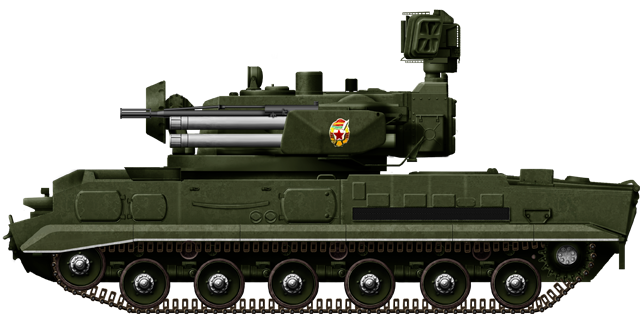
parade
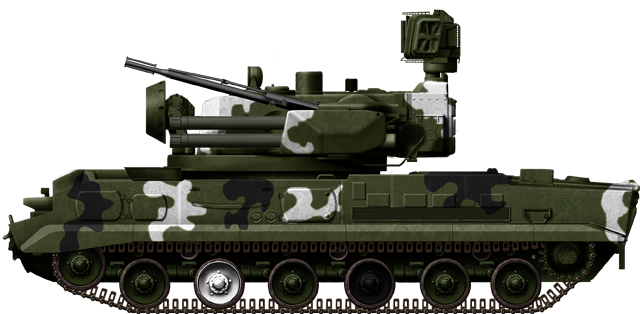
Belarussian 2K22M
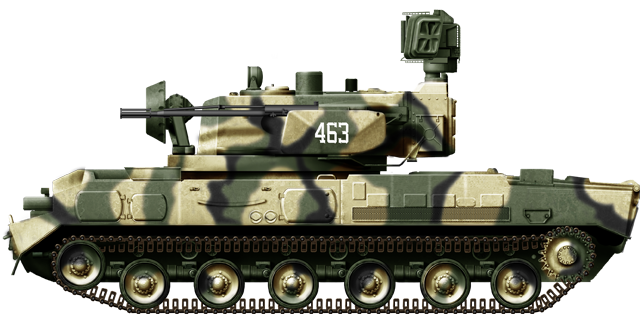
Russian Camouflaged vehicle, 1990s
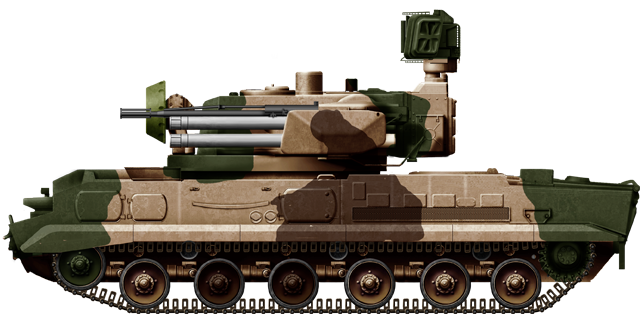
Indian Vehicle
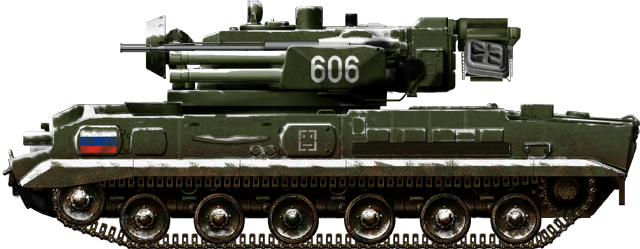
Russian 2K22M in Ukraine, winter 2022-23
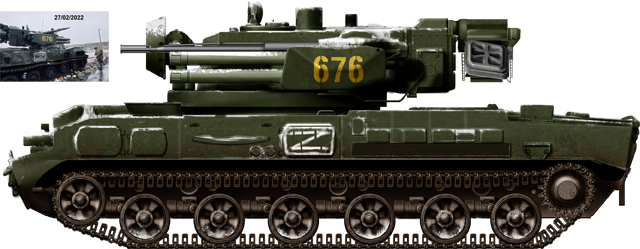
Russian 2K22M1 2022
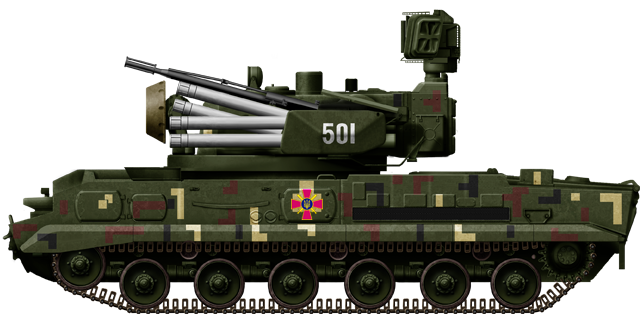
Ukrainian 2K22M1, Kiev parade 2020
Gallery
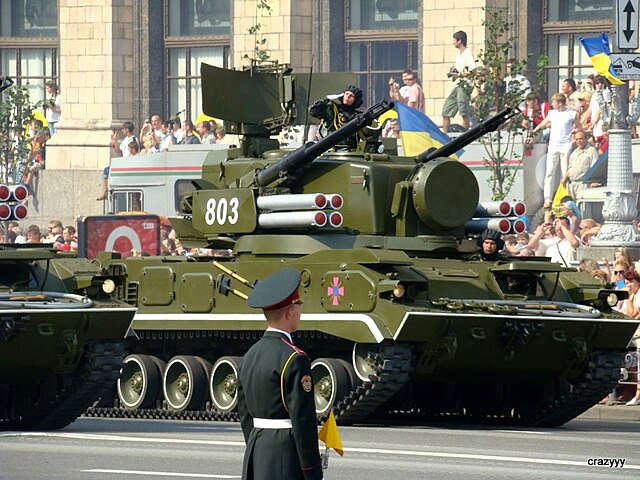
Ukrainian_9K22_Tunguska_vehicles
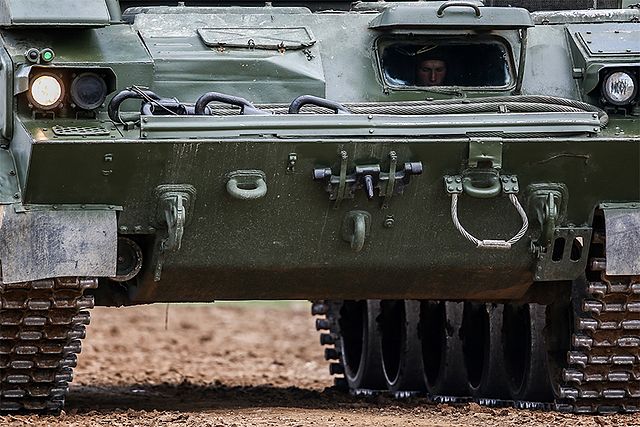
Army-2016_2K22_fwd
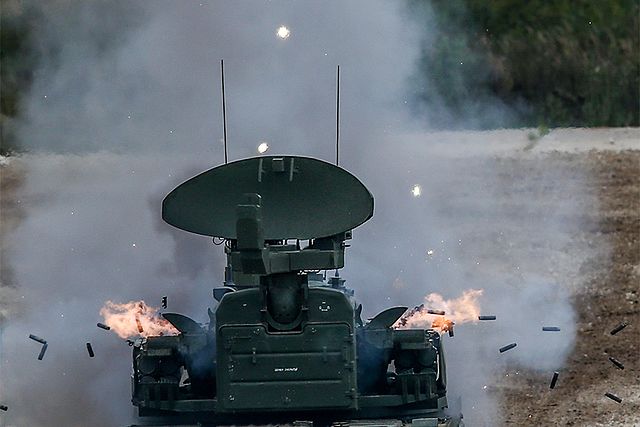
Army-2016_2K22_firing
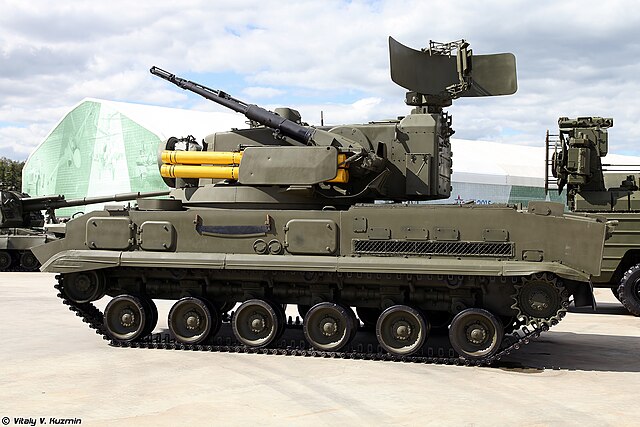
2K22_Park_Patriot_2015_side
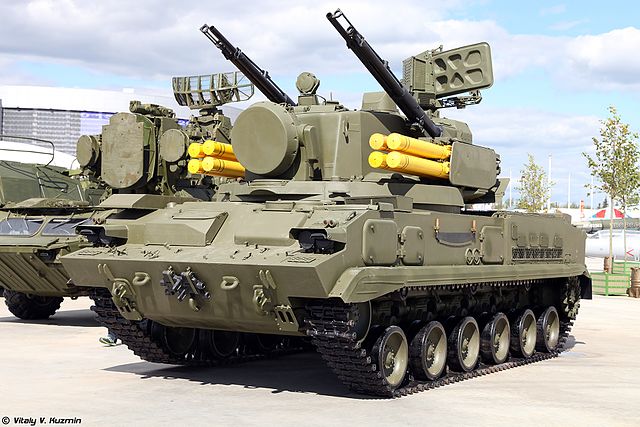
2K22_tunguska_Park_Patriot_2015
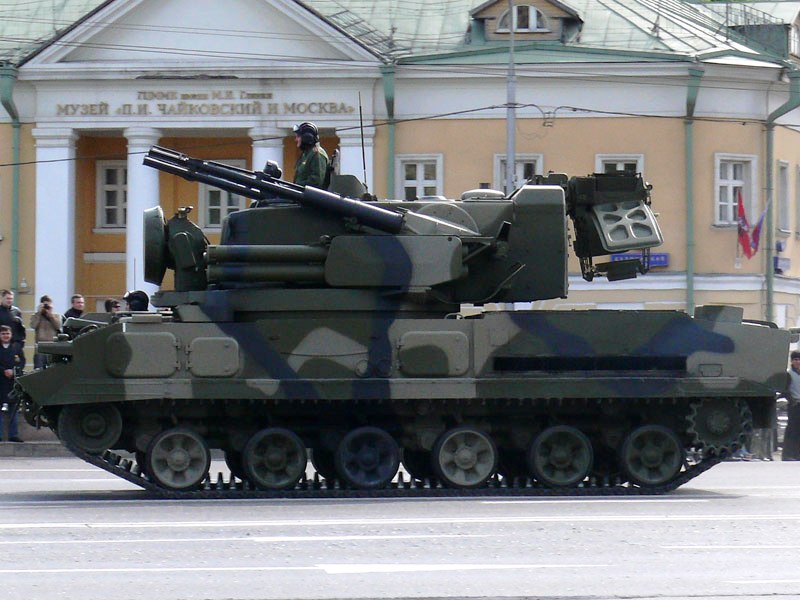
2008_Moscow_Victory_Day_Parade_Tunguska
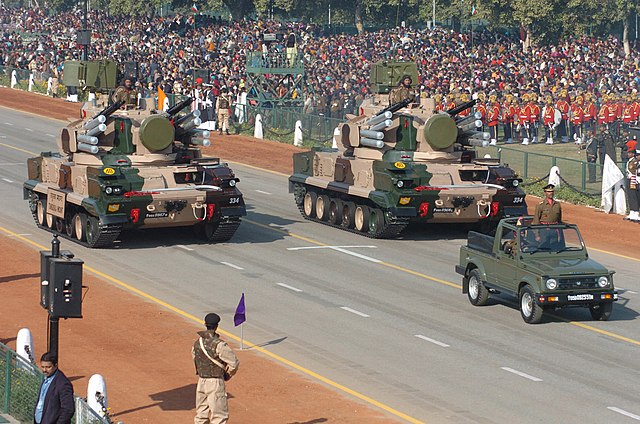
Indian_Tungushka_Rajpath_Rep_Day_Parade_2006_New_Delhi
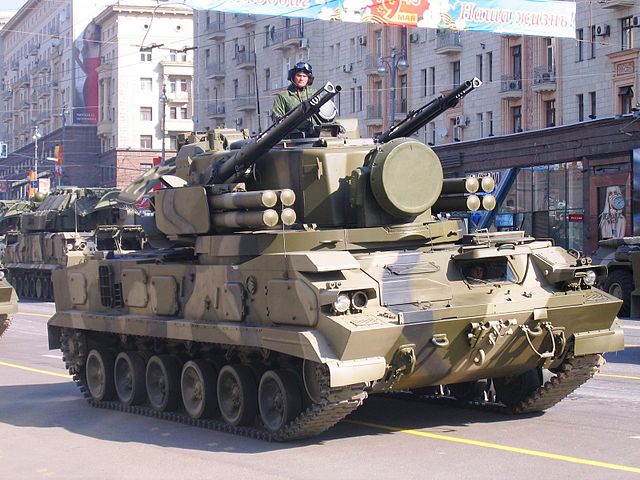
2008_Moscow_May_Parade_Rehearsal_Tunguska
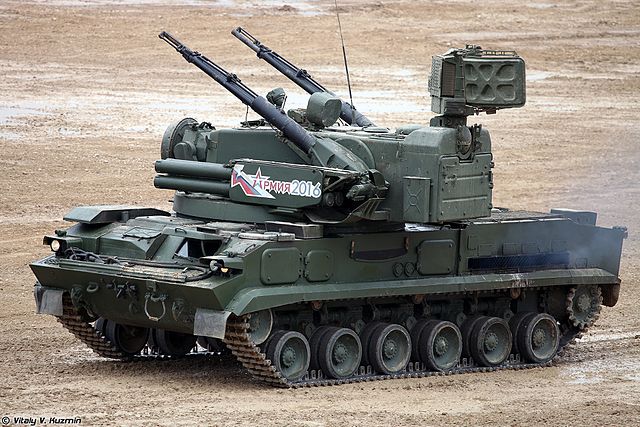
Army_2016d_emo-2S6M1
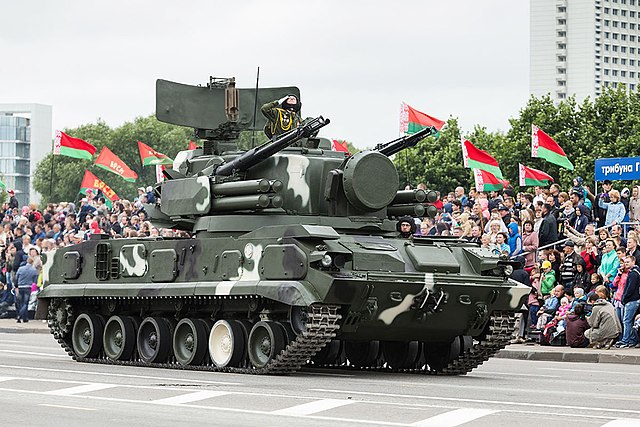
2K22_Tunguska_russia_now
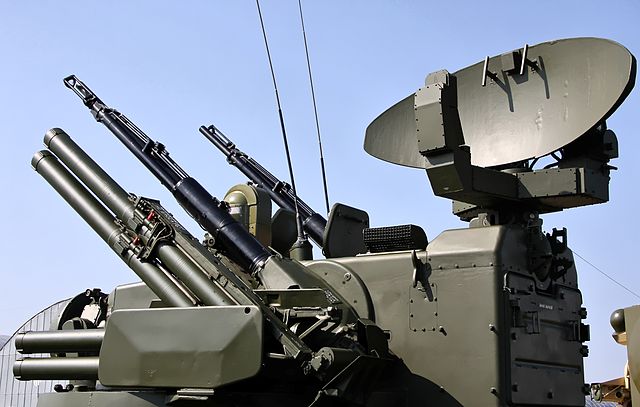
2S6M1_Tunguska-M1_SAM-system
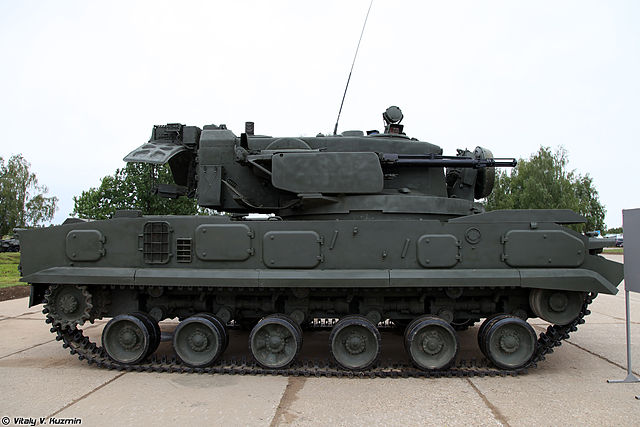
2S6M_combat_vehicle_2K22M_Tunguska-M_TankBiathlon14
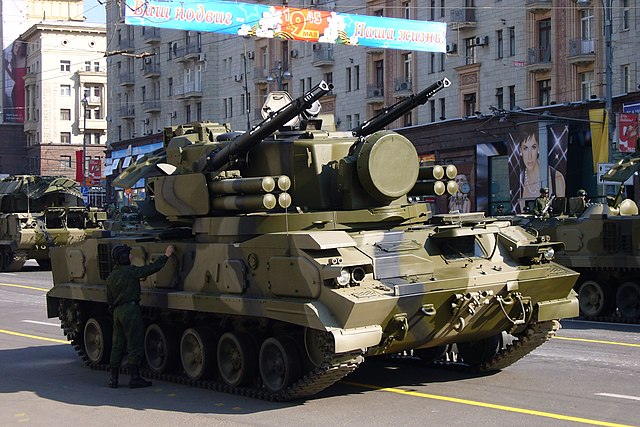
VDay_Parade_Rehearsal_Moscow
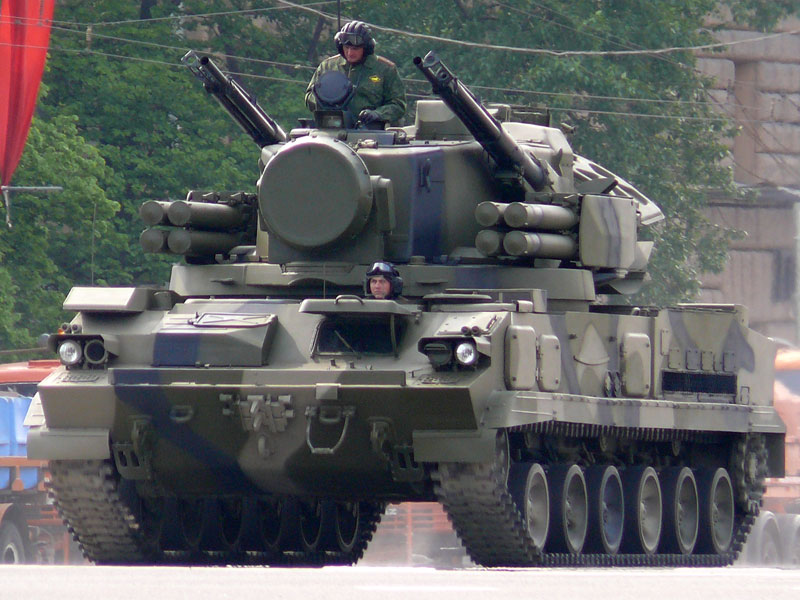
2008_Moscow_Victory_Day_Parade_9K22_Tunguska
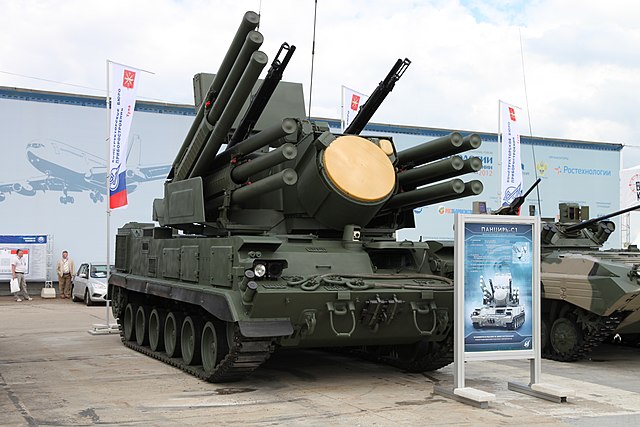
A Tunguska wit the Pansir S1 turret, exhibited here at Engineering Technologies 2012
Related links
Koll, Christian (2009). Soviet Cannon: A Comprehensive Study of Soviet Arms and Ammunition... Austria: Koll.Guardia, Mike (20 May 2015). SPAA, Soviet Bloomsbury Publishing.
kbptula.ru
warfare.be
fmso.leavenworth.army.mil
en.missilery.info
ausairpower.net
armyrecognition.com
www.deagel.com
chtz-uraltrac.com
weaponsystems.net
www.vko.ru/
pvo.guns.ru
astronautix.com/
rbase.new-factoria.ru
www.milparade.ru
fas.org archive
6-ya-tankovaya-brigada-tehnika-i-podgotovka-2
modernarmy.ru
militarytoday.com
mmzavod.ru/
metrowagonmash.ru
man.fas.org
new-factoria.ru
armyrecognition.com
www.kbptula.ru/
structure.mil.ru/
ausairpower.net
360doc.com
mil.in.ua
ukrmilitary.com
armstrade.org/
old.nationaldefense.ru/
vpk.name/
twitter.com/UAWeapons/
Walkaround on dishmodels.ru
odin.tradoc.army.mil
Video

Cold War Tanks


































Cold war tanks posters

Cold War Main Battle Tanks

Cold War Soviet Army
Museums, Movies, Books & Games
The Tanks and Armor in pop culture
Tanks and armored vehicles in general are only really grasped when seen first person: The mass, the scale, it's all there. Explore also the way tanks were covered in the movie industry, in books and in video games.Movies:
Best tanks movie on warhistoryonline.com
On imdb.com
On bestsimilar.com/
miltours.com
liveabout.com/
watchmojo.com
Video Games:
pcgamesn.com
historyhit.com
levvvel.com
vg247.com/best-tank-games
mmobomb.com/
alienwarearena.com


